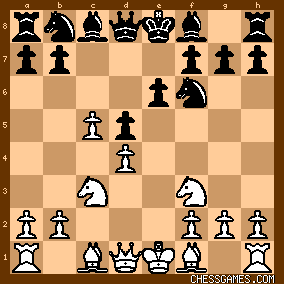Phony Benoni: <vampiero> Perhaps one way to think about 7.c5 is to look at an opening where it is played, such as the Caro-Kann after <1.e4 c6 2.d4 d5 3.exd5 cxd5 4.c4 Nf6 5.Nc3 Nf6 6.c5>

click for larger view
What are the consequences of this push?
1) White has a queenside majority which may become mobile and dangerous. 2) Black is somewhat cramped. His theoretical counterplay is striking at the base of White's pawn chain with ...e5, but that may prove difficult to organize in this position. However, if he can get it in White's queenside pawns could crumble very quickly. 3) White has "released the tension" in the center. This is just grandmasterese for "taken away some of the options for both sides". For instance, neither side has to worry about the consequences of cxd5 or ...dxc4. Strong players prefer to keep these options as long as possible, feeling confident in their ability to assess the complications. Not-so-strong players without such confidence often prefer to lessen the tension to make the game seem easier to play. In general, I believe that 6.c5 is considered a risky but playable idea. Now, look again at the game position after 7.c5. 1) is not present; White does not have the potential advantage of the queenside majority. 2) is present, but Black is much better organized toward playing ...e5, though White's pawn on e3 will help stabilize his formation. As for 3), notice that White has released the tension without any clear plan. In the Caro-Kann line he has the queenside majority to work on; here, his has some extra space on the queenside but nothing do do with it while Black has definite counterplay. Watch what happens in the game. To protect his advanced c-pawn, White has to push forward his b-pawn without adequate support. Black gets in ...e5 and has solid kingside play which eventually destroys White's queenside pawns. | 




